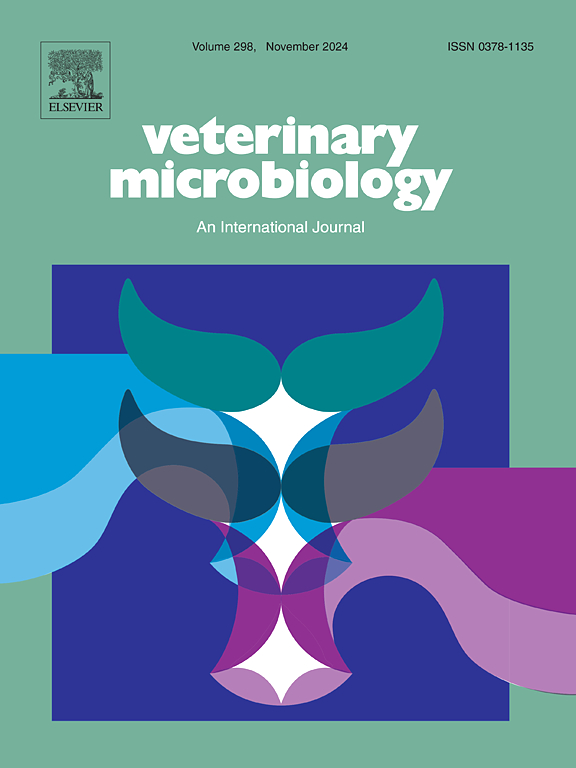MDV-encoded protein kinase US3 phosphorylates WTAP to inhibit transcriptomic m6A modification and cellular protein translation
IF 2.7
2区 农林科学
Q3 MICROBIOLOGY
引用次数: 0
Abstract
Marek’s disease virus (MDV)-encoded US3 is a highly conserved serine/threonine protein kinase in alpha-herpesviruses. In other alpha-herpesviruses, such as pseudorabies virus (PRV), US3 phosphorylates the N6-methyladenosine (m6A) methyltransferase Wilms tumor 1-associated protein (WTAP), inhibiting m6A modification. However, the role and mechanism of US3-mediated WTAP phosphorylation during MDV infection remain undefined. Our study revealed that MDV infection in vitro does not alter WTAP expression, while significant changes in WTAP expression occur during the MDV life cycle in vivo. We demonstrated that MDV-encoded US3 interacts with and co-localizes with WTAP in the nucleus. Further analysis showed that US3 binds to WTAP's C-terminal domain and phosphorylates WTAP at S273, S305, S314, and S375. Notably, the interaction between US3 and WTAP does not affect WTAP stability but inhibits transcriptomic m6A modification and cellular protein translation. Therefore, these findings enhance our understanding of the molecular mechanisms underlying MDV infection.
mdv编码的蛋白激酶US3磷酸化WTAP,抑制转录组m6A修饰和细胞蛋白翻译。
马立克氏病病毒(MDV)编码的US3是α -疱疹病毒中高度保守的丝氨酸/苏氨酸蛋白激酶。在其他α -疱疹病毒中,如伪狂犬病毒(PRV), US3磷酸化n6 -甲基腺苷(m6A)甲基转移酶Wilms肿瘤1相关蛋白(WTAP),抑制m6A修饰。然而,us3介导的WTAP磷酸化在MDV感染中的作用和机制尚不清楚。我们的研究表明,体外MDV感染不会改变WTAP的表达,而体内MDV生命周期中WTAP的表达会发生显著变化。我们证明了mdv编码的US3与细胞核中的WTAP相互作用并共定位。进一步分析表明,US3结合WTAP的c端结构域,磷酸化WTAP的S273、S305、S314和S375位点。值得注意的是,US3和WTAP之间的相互作用不影响WTAP的稳定性,但会抑制转录组m6A修饰和细胞蛋白翻译。因此,这些发现增强了我们对MDV感染的分子机制的理解。
本文章由计算机程序翻译,如有差异,请以英文原文为准。
求助全文
约1分钟内获得全文
求助全文
来源期刊

Veterinary microbiology
农林科学-兽医学
CiteScore
5.90
自引率
6.10%
发文量
221
审稿时长
52 days
期刊介绍:
Veterinary Microbiology is concerned with microbial (bacterial, fungal, viral) diseases of domesticated vertebrate animals (livestock, companion animals, fur-bearing animals, game, poultry, fish) that supply food, other useful products or companionship. In addition, Microbial diseases of wild animals living in captivity, or as members of the feral fauna will also be considered if the infections are of interest because of their interrelation with humans (zoonoses) and/or domestic animals. Studies of antimicrobial resistance are also included, provided that the results represent a substantial advance in knowledge. Authors are strongly encouraged to read - prior to submission - the Editorials (''Scope or cope'' and ''Scope or cope II'') published previously in the journal. The Editors reserve the right to suggest submission to another journal for those papers which they feel would be more appropriate for consideration by that journal.
Original research papers of high quality and novelty on aspects of control, host response, molecular biology, pathogenesis, prevention, and treatment of microbial diseases of animals are published. Papers dealing primarily with immunology, epidemiology, molecular biology and antiviral or microbial agents will only be considered if they demonstrate a clear impact on a disease. Papers focusing solely on diagnostic techniques (such as another PCR protocol or ELISA) will not be published - focus should be on a microorganism and not on a particular technique. Papers only reporting microbial sequences, transcriptomics data, or proteomics data will not be considered unless the results represent a substantial advance in knowledge.
Drug trial papers will be considered if they have general application or significance. Papers on the identification of microorganisms will also be considered, but detailed taxonomic studies do not fall within the scope of the journal. Case reports will not be published, unless they have general application or contain novel aspects. Papers of geographically limited interest, which repeat what had been established elsewhere will not be considered. The readership of the journal is global.
 求助内容:
求助内容: 应助结果提醒方式:
应助结果提醒方式:


